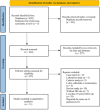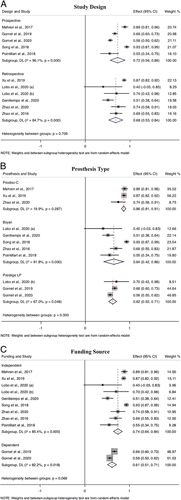Incidence of Heterotopic Ossification at 10 years After Cervical Disk Replacement: A Systematic Review and Meta-analysis
- PMID: 37036304
- PMCID: PMC10249612
- DOI: 10.1097/BRS.0000000000004674
Incidence of Heterotopic Ossification at 10 years After Cervical Disk Replacement: A Systematic Review and Meta-analysis
Abstract
Study design: Systematic review and meta-analysis.
Objective: This study aimed to assess the incidence of heterotopic ossification (HO) 10 years after cervical disk replacement (CDR).
Summary of background data: HO is a common complication after CDR and may limit the range of motion of the artificial disk. As HO usually progresses slowly, a long-term follow-up is required to better understand its incidence. In recent years, the increasing number of original articles reporting 10-year outcomes gives us the opportunity to better understand the long-term incidence of HO.
Materials and methods: We searched PubMed, Medline, Embase, and Cochrane Library databases to identify eligible studies. The incidence of HO was pooled, and subgroup analysis was performed. Meta-regression analyses were conducted to identify factors contributing to heterogeneity.
Results: Eleven studies with at least 10 years of follow-up comprising 1140 patients who underwent CDR were included. The pooled incidence of overall HO was 70% (95% CI, 60%-81%) at 10 years postoperatively, 60% (95% CI, 44%-75%) at five or six years postoperatively, and 50% (95% CI, 27%-72%) at one or two years postoperatively. The pooled incidence of severe HO (grade 3 or 4) was 37% (95% CI, 29%-45%), and mild HO (grade 1 to 2) was 30% (95% CI, 17%-44%) at 10 years of follow-up. Pooled range of motion decreased from 8.59° before surgery to 7.40° 10 years after surgery. Subgroup analysis showed that HO incidence differed according to the prosthesis type. The earlier publication was associated with a higher pooled incidence of severe HO in the meta-regression analysis.
Conclusions: This is the first meta-analysis providing detailed information on the pooled 10-year incidence of HO after CDR. The incidence of HO seems to increase with the length of follow-up.
Level of evidence: 3.
Copyright © 2023 The Author(s). Published by Wolters Kluwer Health, Inc.
Conflict of interest statement
The authors report no conflicts of interest.
Figures





Similar articles
-
The prevalence of heterotopic ossification among patients after cervical artificial disc replacement: A systematic review and meta-analysis.Medicine (Baltimore). 2017 Jun;96(24):e7163. doi: 10.1097/MD.0000000000007163. Medicine (Baltimore). 2017. PMID: 28614250 Free PMC article.
-
Arthroplasty versus fusion in single-level cervical degenerative disc disease.Cochrane Database Syst Rev. 2012 Sep 12;(9):CD009173. doi: 10.1002/14651858.CD009173.pub2. Cochrane Database Syst Rev. 2012. Update in: Cochrane Database Syst Rev. 2015 May 21;(5):CD009173. doi: 10.1002/14651858.CD009173.pub3. PMID: 22972137 Updated.
-
Long-term results of cervical disc arthroplasty: a single-center retrospective study with a minimum 10-year follow-up.J Neurosurg Spine. 2025 Jun 6;43(2):195-204. doi: 10.3171/2025.2.SPINE241185. Print 2025 Aug 1. J Neurosurg Spine. 2025. PMID: 40479833
-
Factors that may affect outcome in cervical artificial disc replacement: a systematic review.Eur Spine J. 2015 Sep;24(9):2023-32. doi: 10.1007/s00586-015-4096-6. Epub 2015 Jul 9. Eur Spine J. 2015. PMID: 26155894
-
Drugs for preventing postoperative nausea and vomiting in adults after general anaesthesia: a network meta-analysis.Cochrane Database Syst Rev. 2020 Oct 19;10(10):CD012859. doi: 10.1002/14651858.CD012859.pub2. Cochrane Database Syst Rev. 2020. PMID: 33075160 Free PMC article.
Cited by
-
Adjacent segment degeneration after single- and double-level cervical total disc replacement: a cohort with an over 12-year follow-up.Eur Spine J. 2024 Jan;33(1):232-242. doi: 10.1007/s00586-023-08018-3. Epub 2023 Nov 10. Eur Spine J. 2024. PMID: 37947890
-
Cervical Disc Arthroplasty (CDA) versus Anterior Cervical Discectomy and Fusion (ACDF) for Two-Level Cervical Disc Degenerative Disease: An Updated Systematic Review and Meta-Analysis.J Clin Med. 2024 May 29;13(11):3203. doi: 10.3390/jcm13113203. J Clin Med. 2024. PMID: 38892914 Free PMC article. Review.
-
Comparison of 10-year follow-up result of hybrid surgery and anterior cervical discectomy and fusion for the treatment of contiguous three-level cervical degenerative disc diseases: risk factors for heterotopic ossification.Eur Spine J. 2025 Sep 6. doi: 10.1007/s00586-025-09329-3. Online ahead of print. Eur Spine J. 2025. PMID: 40913198
-
Cervical Disc Arthroplasty: Rationale, Designs, and Results of Randomized Controlled Trials.Int J Spine Surg. 2024 Feb 27;18(3):258-76. doi: 10.14444/8586. Online ahead of print. Int J Spine Surg. 2024. PMID: 38413235 Free PMC article.
References
-
- Zhou F, Ju KL, Zhao Y, et al. . Progressive bone formation after cervical disc replacement: minimum of 5-year follow-up. Spine. 2018;43:E163–70. - PubMed
-
- Eck JC, Humphreys SC, Lim TH, et al. . Biomechanical study on the effect of cervical spine fusion on adjacent-level intradiscal pressure and segmental motion. Spine. 2002;27:2431–34. - PubMed
-
- Lanman TH, Burkus JK, Dryer RG, Gornet MF, McConnell J, Hodges SD. Long-term clinical and radiographic outcomes of the Prestige LP artificial cervical disc replacement at 2 levels: results from a prospective randomized controlled clinical trial. J Neurosurg Spine. 2017;27:7–19. - PubMed
-
- Murrey D, Janssen M, Delamarter R, et al. . Results of the prospective, randomized, controlled multicenter Food and Drug Administration investigational device exemption study of the ProDisc-C total disc replacement versus anterior discectomy and fusion for the treatment of 1-level symptomatic cervical disc disease. Spine J. 2009;9:275–86. - PubMed
-
- Davis RJ, Kim KD, Hisey MS, et al. . Cervical total disc replacement with the Mobi-C cervical artificial disc compared with anterior discectomy and fusion for treatment of 2-level symptomatic degenerative disc disease: a prospective, randomized, controlled multicenter clinical trial: clinical article. J Neurosurg Spine. 2013;19:532–45. - PubMed
Publication types
MeSH terms
LinkOut - more resources
Full Text Sources
Medical
Research Materials

